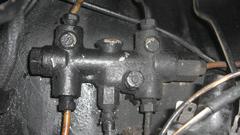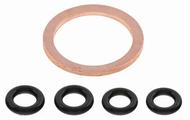The MGA With An Attitude
Dual Line PRESSURE FAILURE WARNING SWITCH - BT-206A
 With the dual line system there is normally a part that looks like an H-shape 6-way fitting near the master cylinder. This is the dual line Pressure Failure Warning Switch. The front end port is for master cylinder front circuit input. The first two side ports are for front brake lines out to the front wheels, making this end of the valve a 3-way block. The last two side ports are for master cylinder rear circuit input, and rear brake pipe out. That last pipe goes to a 3-way block on the rear axle to split it for the two rear brakes.
With the dual line system there is normally a part that looks like an H-shape 6-way fitting near the master cylinder. This is the dual line Pressure Failure Warning Switch. The front end port is for master cylinder front circuit input. The first two side ports are for front brake lines out to the front wheels, making this end of the valve a 3-way block. The last two side ports are for master cylinder rear circuit input, and rear brake pipe out. That last pipe goes to a 3-way block on the rear axle to split it for the two rear brakes.
There is another version of this pressure failure switch having one additional port on
 the far end. This allows the far end to serve as another 3-way block, so you can run 4 separate brake pipes to the four corners of the car. That would also require two flex hoses to the rear axle (more likely found on cars with independent rear suspension). The sweet feature of the 7-port valve is that it can be connected to have diagonal braking, with one master circuit feeding left front and right rear brakes, and the other master circuit, feeding right front and left rear brakes. --- That configuration could make the steering pull somewhat to one side or the other in case of a pressure failure in one circuit, but it does avoid the possibility of having to bring the car to stop from speed using only the rear brakes. I did find one of these 7-port pressure failure valves on an MGC, but the tail end port was plugged (not used), so it was not being used for diagonal circuits.
the far end. This allows the far end to serve as another 3-way block, so you can run 4 separate brake pipes to the four corners of the car. That would also require two flex hoses to the rear axle (more likely found on cars with independent rear suspension). The sweet feature of the 7-port valve is that it can be connected to have diagonal braking, with one master circuit feeding left front and right rear brakes, and the other master circuit, feeding right front and left rear brakes. --- That configuration could make the steering pull somewhat to one side or the other in case of a pressure failure in one circuit, but it does avoid the possibility of having to bring the car to stop from speed using only the rear brakes. I did find one of these 7-port pressure failure valves on an MGC, but the tail end port was plugged (not used), so it was not being used for diagonal circuits.
The top port is for a mechanical switch to operate a warning light on the dash. In the center of the H-body is a differential pressure shuttle. When pressure is higher on one side the shuttle moves to operate the warning switch. The system will work without the warning switch (and dash lamp), but will give no notice of a pressure failure. If you lost pressure in the rear brakes you might not notice it (just slightly higher pedal force) until you have to do a panic stop, and the braking distance is double what you might expect. This is why the pressure failure warning light is so important, and why the shuttle switch function needs to be checked occasionally to be properly maintained.
You can test the shuttle switch by opening one bleed nipple to kill pressure in one circuit only (front or rear), press the brake pedal, and see if the warning switch lights up on the dash. Tighten the bleed nipple while the pedal is still held down. You should do this test at both ends of the car. The warning light should
 light up for a pressure failure at either end of the car, and should go out when the pedal is up. ---
If it doesn't work properly it can be repaired. Take it apart, clean it up, install two new tiny O-rings (5/16" OD, 3/16" ID, 1/16" wide from a local auto parts store), and put it back together. Or buy the repair kit cheap.
light up for a pressure failure at either end of the car, and should go out when the pedal is up. ---
If it doesn't work properly it can be repaired. Take it apart, clean it up, install two new tiny O-rings (5/16" OD, 3/16" ID, 1/16" wide from a local auto parts store), and put it back together. Or buy the repair kit cheap.
|